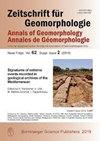利用激光雷达数据量化人工排水网络的河岸侵蚀
IF 1.3
3区 地球科学
Q3 GEOGRAPHY, PHYSICAL
引用次数: 4
摘要
随着欧洲低地耕地向集约化农业的转变,农田面积增加了,溪流河谷的曲流得到了抑制,并沿着新的直线农田边界重新排列。这些变化导致溪流的水形态发生了深刻的变化。为了检验这些改进的重要性,本研究的目的是评估使用高分辨率DTM(数字地形模型)在集水区尺度上量化小型排水沟渠当前体积的潜力,并利用档案数据评估这些沟渠的演变。该方法已应用于一个由人工水网排水的小型农业集水区。选择了一条1400 m长的沟来估算0.5 m的DTM的容量,并评估实际地形和水流的体积。用厘米差分全球定位系统(DGPS)测量了44个通道截面,并与DTM测量的相同剖面进行了比较。估计流深度的平均DTM误差约为13%,而检测流宽度的平均DTM误差小于12%。使用DTM剖面而不是DGPS剖面估算沟渠容积的结果为3100立方米。DGPS和DTM方法估算的沟槽体积存在差异,平均误差为11%,这主要是由于DTM方法对底沟槽形态的估计不足造成的。这项研究强调了机载仪器快速、可靠地检测和估计大面积小宽度流网络(1.5至4米)所占体积的能力。这种方法为在流域尺度上研究当前和过去的河岸活动开辟了新的视角,以量化河岸侵蚀对总体泥沙收支的贡献。本文章由计算机程序翻译,如有差异,请以英文原文为准。
Quantification of bank erosion of artificial drainage networks using LiDAR data
Following the shift towards more intensive agriculture in cultivated lowlands in Europe, field sizes have increased and stream valley meanderings have been suppressed and realigned along new straight field borders. These modifications have led to profound alterations of the hydromorphology of the streams. To test the importance of these modifications, the objective of this study is to assess the potential of using high resolution DTM (Digital Terrain Model) to quantify the current volume of small drainage ditches at catchment scales and to assess the evolution of these ditches using archival data. The method has been applied to a small agricultural catchment drained by an artificial stream network. A specific 1400 m long ditch was chosen to estimate the capacity of a DTM (0.5 m) and to evaluate the actual topography and volume of stream. Forty-four channel cross sections measured with a centimeter DGPS (Differential Global Positioning System) have been compared with the same profiles measured with the DTM. The average DTM error in estimating stream depth is approximately 13% and is less than 12% for stream width detection. Estimates of the ditch volume using DTM sections instead of DGPS sections produces a result of 3100 m3. An average error of 11% can be ascribed to the difference in the estimated ditch volume between the DGPS and DTM approaches, which was principally caused by under-estimates of bottom ditch morphology by the DTM. This study highlights the ability of airborne instruments to quickly and robustly detect and estimate the volume occupied by small-width stream networks (1.5 to 4 m) over large areas. This approach has opened new perspectives for the study of current and past bank activities at catchment scales to quantify bank erosion contributions to the overall sediment budget.
求助全文
通过发布文献求助,成功后即可免费获取论文全文。
去求助
来源期刊

Zeitschrift fur Geomorphologie
地学-地球科学综合
CiteScore
2.00
自引率
4.50%
发文量
14
审稿时长
6-12 weeks
期刊介绍:
Zeitschrift für Geomorphologie main volume is a peer-reviewed international journal presenting original contributions of high scientific standard from all fields of geomorphology, encompassing basic research and applied studies. Zeitschrift für Geomorphologie (ZfG) invites the submission of original papers from the entire field of geomorphological research, both applied and theoretical. Authors are encouraged to submit their papers to the editor-in-chief. Please peruse the instructions to authors (PDF) before submitting your paper.
 求助内容:
求助内容: 应助结果提醒方式:
应助结果提醒方式:


